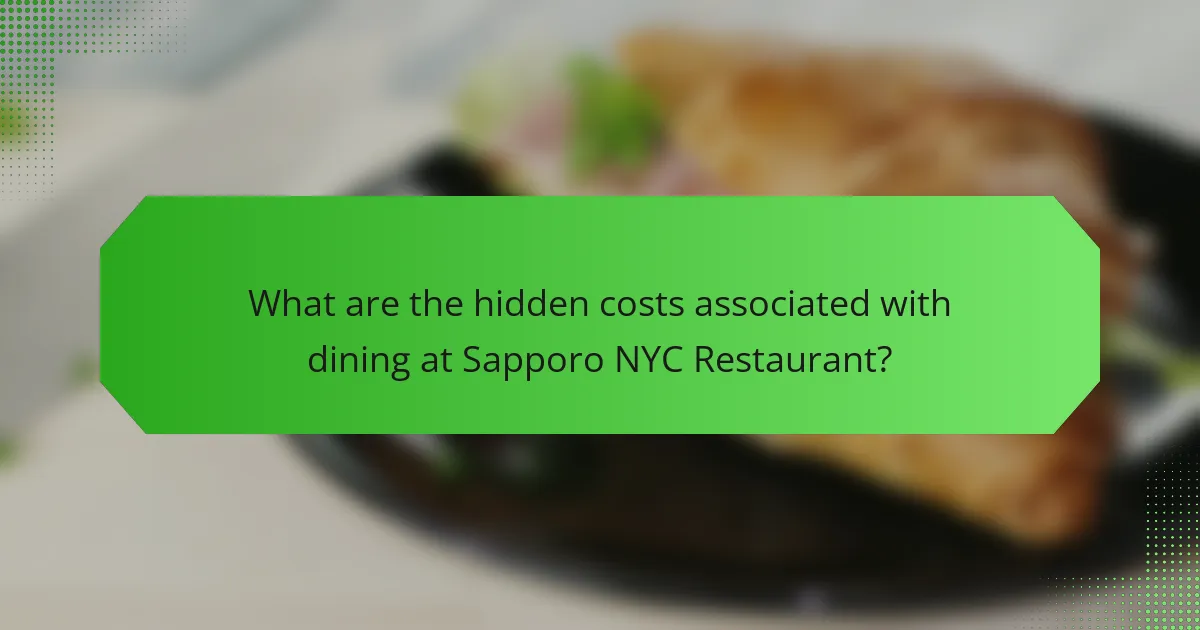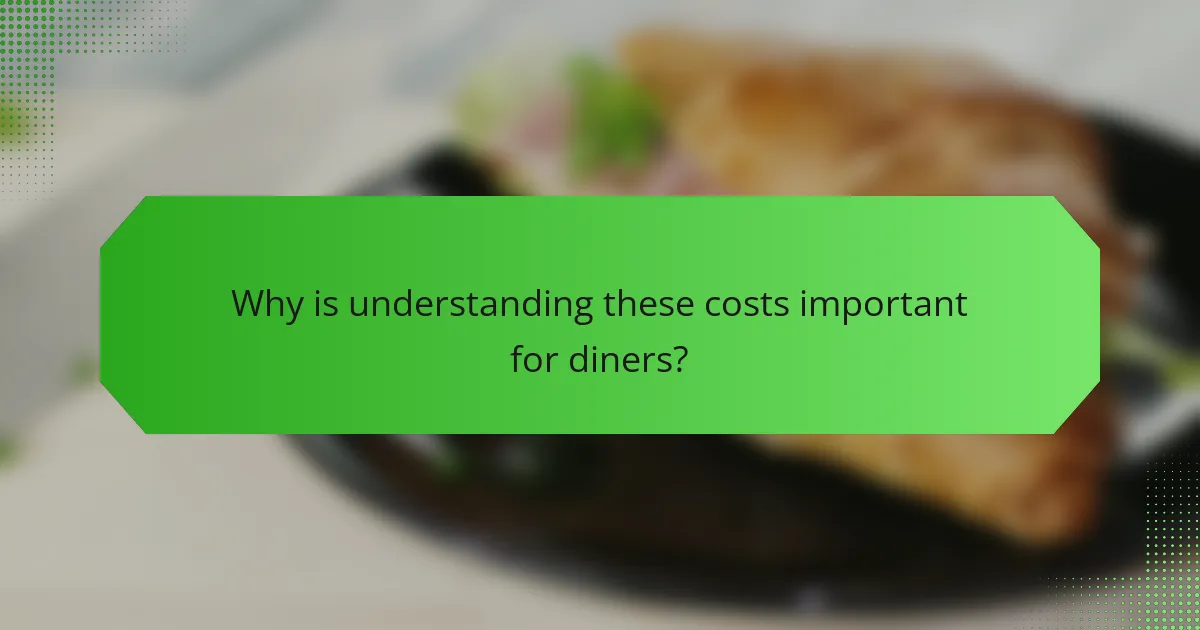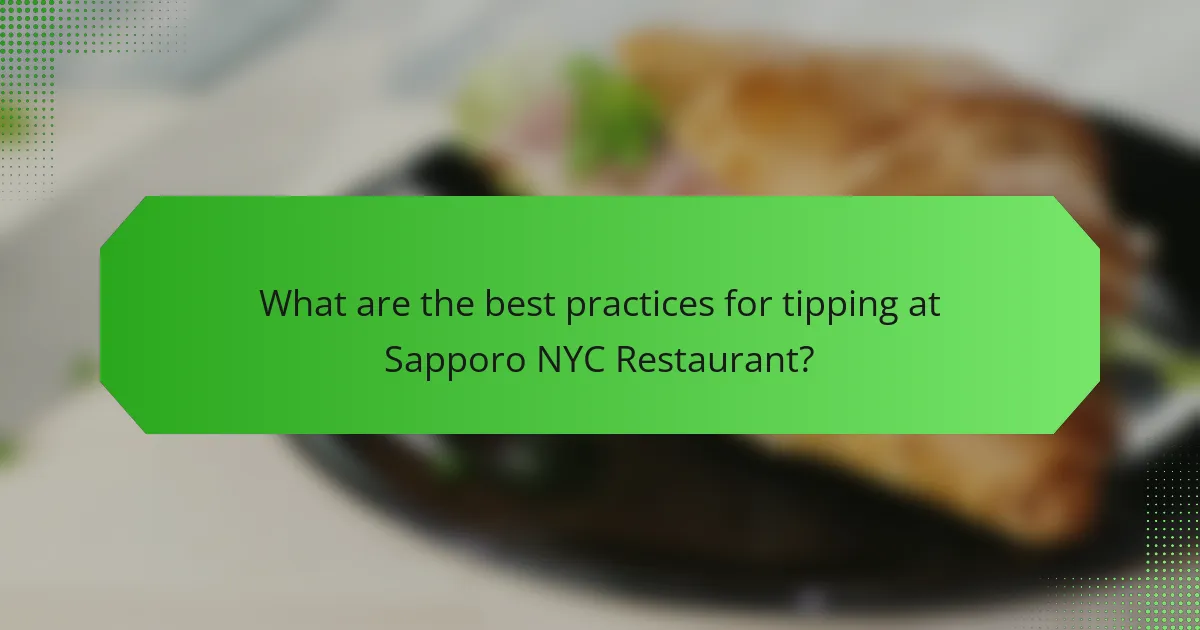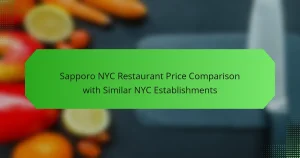
What are the hidden costs associated with dining at Sapporo NYC Restaurant?
Hidden costs associated with dining at Sapporo NYC Restaurant include gratuity and additional fees. Gratuity is automatically added to the bill for larger parties, typically 18-20%. This can lead to unexpected total costs for diners. Additional fees may include service charges or taxes that are not clearly outlined on the menu. Patrons should also consider the cost of drinks, which can significantly raise the final bill. Lastly, parking fees in the area may add to the overall dining expense. Transparency about these costs can vary, making it essential for diners to inquire beforehand.
How is gratuity calculated at Sapporo NYC Restaurant?
Gratuity at Sapporo NYC Restaurant is typically calculated as a percentage of the total bill. The standard gratuity rate is 18% for parties of six or more. This amount is automatically added to the bill. For smaller parties, gratuity is left to the discretion of the customer. Customers can adjust the gratuity amount based on service quality. The restaurant’s policy is designed to ensure fair compensation for staff. This practice is common in many dining establishments.
What percentage is typically added for gratuity?
A typical percentage added for gratuity is 15% to 20%. This range is commonly accepted in the restaurant industry. Many establishments automatically include gratuity for larger parties. Some places may suggest a specific percentage on the bill. Gratuity amounts can vary by region and type of service. In New York City, 18% is often considered standard. This practice is supported by industry norms and customer expectations.
Are there different rates for parties of varying sizes?
Yes, there are different rates for parties of varying sizes. Sapporo NYC Restaurant implements specific pricing structures based on the number of guests. For instance, larger groups may incur additional fees or minimum spending requirements. These policies are designed to accommodate the increased service demands of bigger parties. Typically, the rates can vary significantly, depending on the size of the group. It is advisable to inquire directly with the restaurant for precise details regarding their pricing for different party sizes.
What additional fees should diners be aware of?
Diners at Sapporo NYC should be aware of several additional fees. These include a service charge, which is typically around 18%. There may also be a corkage fee for bringing your own wine, usually ranging from $20 to $30. Some menu items may have additional charges for customization or special requests. Taxes are also added to the final bill, generally around 8.875% in New York City. Additionally, diners should check for any promotional fees or surcharges during special events. Understanding these fees can help diners manage their overall expenses effectively.
What types of service charges are applied?
Sapporo NYC Restaurant applies several types of service charges. These include a mandatory gratuity for large parties, usually set at 18-20%. There may also be a service charge for special events or private dining experiences. Additionally, a delivery fee can be applied for takeout orders. These charges are clearly outlined on the menu or bill. Understanding these fees helps customers anticipate total costs. Transparency in pricing is essential for customer satisfaction.
Are there any fees for special requests or accommodations?
Yes, Sapporo NYC Restaurant may charge fees for special requests or accommodations. These fees can vary based on the nature of the request. For example, modifications to menu items or specific dietary accommodations might incur additional charges. It is advisable to inquire directly with the restaurant for exact details on any potential fees. This practice ensures transparency and helps customers understand the total cost of their dining experience.

Why is understanding these costs important for diners?
Understanding these costs is crucial for diners to manage their budgets effectively. Hidden costs can significantly increase the total bill, leading to unexpected expenses. Gratuity and additional fees often vary by restaurant, impacting the overall dining experience. Being aware of these charges allows diners to make informed decisions. It also helps them to evaluate the value of the service received. Research shows that diners who understand pricing structures report higher satisfaction levels. This knowledge can enhance their overall dining experience and prevent financial surprises.
How can hidden costs impact the overall dining experience?
Hidden costs can significantly detract from the overall dining experience. These costs may include unexpected gratuities, service fees, or additional charges not clearly stated on the menu. When diners are unaware of these expenses, they may feel misled or frustrated. This can lead to dissatisfaction with the service and the restaurant’s transparency. Research indicates that 70% of diners are more likely to return if they feel they received clear pricing information. Hidden costs can create a sense of distrust, impacting the likelihood of repeat visits. Overall, transparency in pricing enhances customer satisfaction and loyalty.
What are the common misconceptions about gratuity and fees?
Common misconceptions about gratuity and fees include the belief that gratuity is optional and that all fees are hidden. Many assume that tips are not mandatory, but they often are expected in service industries. Another misconception is that all additional fees are disclosed upfront, when in reality, some may be added at the end of the bill. People often think gratuity is a percentage of the total bill, but it can vary based on service quality. Additionally, some believe that gratuity is included in the price, which is not always the case. Understanding these misconceptions can help diners navigate costs more effectively.
How can diners prepare for unexpected charges?
Diners can prepare for unexpected charges by reviewing the menu and pricing details carefully before ordering. This includes checking for any notes about additional fees or gratuity. Many restaurants, especially in NYC, may include service charges automatically. Diners should also ask staff about any hidden costs upfront. It is wise to budget extra funds for potential unexpected charges. Being aware of common practices, such as mandatory gratuity for large parties, can help diners plan accordingly. Checking online reviews or forums may provide insights into others’ experiences regarding charges at specific restaurants.
What strategies can diners use to manage their expenses?
Diners can manage their expenses by planning their meals in advance. Research menus online to identify affordable options. Choose restaurants with transparent pricing to avoid hidden fees. Consider dining during happy hours for discounted rates. Share dishes to reduce costs while enjoying a variety of flavors. Opt for water instead of expensive beverages to save money. Utilize coupons or promotional offers when available. These strategies help diners minimize expenses effectively while dining out.
What tips can help diners budget for their meal at Sapporo NYC Restaurant?
To budget for a meal at Sapporo NYC Restaurant, diners should review the menu prices in advance. This helps set realistic expectations for total costs. Diners can also consider dining during lunch hours when prices may be lower. Additionally, sharing dishes can reduce individual expenses. It’s important to account for gratuity, typically 18-20% of the bill, which can significantly affect the total cost. Checking for any additional fees, such as service charges, is also advisable. Finally, diners should keep an eye out for special promotions or discounts that may be available. These strategies enable better financial planning for a dining experience at Sapporo NYC Restaurant.
How can diners inquire about fees before their visit?
Diners can inquire about fees before their visit by checking the restaurant’s website. Many restaurants provide detailed information about fees, including gratuity and service charges, online. Diners can also call the restaurant directly to ask about any additional costs. Speaking with a staff member can clarify any uncertainties regarding fees. This practice helps diners prepare financially for their meal. Additionally, some restaurants may include fee information in their reservation confirmation emails. By utilizing these methods, diners can ensure they are aware of all potential costs.

What are the best practices for tipping at Sapporo NYC Restaurant?
The best practice for tipping at Sapporo NYC Restaurant is to leave 15-20% of the total bill. This range aligns with standard tipping practices in New York City. For exceptional service, consider tipping above 20%. Always check if a service charge is included in the bill, as some restaurants automatically add it. If a service charge is included, you may choose to tip less or not at all. Tipping in cash is often preferred, but credit card tips are also accepted. Ensuring your tip reflects the quality of service is essential. This practice supports the staff and acknowledges their efforts in providing a positive dining experience.
How much should diners consider tipping based on service quality?
Diners should consider tipping between 15% to 20% based on service quality. A tip of 15% is generally considered acceptable for satisfactory service. For exceptional service, a tip of 20% or more is encouraged. The standard practice in the restaurant industry reflects these percentages. According to the National Restaurant Association, tipping is a significant part of servers’ income. This practice incentivizes quality service and acknowledges the effort of restaurant staff.
What factors influence the decision on gratuity amounts?
Factors influencing gratuity amounts include service quality, dining experience, and bill total. Service quality is a primary determinant. Positive interactions lead to higher tips. Conversely, poor service results in lower gratuities. The overall dining experience also plays a role. Ambiance and food quality can affect customer satisfaction. Higher bills typically correlate with larger gratuity percentages. Standard tipping practices suggest 15-20% of the total bill. Cultural norms and expectations further influence gratuity decisions. In some regions, tipping is more customary than in others. Personal values and beliefs about service compensation can also impact choices.
What should diners do if they feel the service does not warrant the suggested gratuity?
Diners who feel the service does not warrant the suggested gratuity should consider adjusting the tip amount. They can reflect their dissatisfaction by leaving a lower percentage. Communicating concerns to the management can also be beneficial. This allows the restaurant to address service issues. Many diners choose to leave cash tips instead of including gratuity on the bill. This method gives them more control over the amount. Research indicates that tipping practices often correlate with service quality. Therefore, adjusting gratuity can signal to the establishment the level of service received.
How can diners communicate their concerns regarding service and fees?
Diners can communicate their concerns regarding service and fees by directly speaking to the restaurant staff. This includes servers, managers, or customer service representatives. Clear and respectful communication is essential for effective dialogue. Diners should express specific issues, such as dissatisfaction with service or unexpected charges. Providing feedback can lead to immediate resolutions. Many restaurants also encourage feedback through comment cards or online surveys. Utilizing these methods allows diners to share their experiences after dining. According to a survey by the National Restaurant Association, 70% of diners appreciate when restaurants address their concerns promptly. This demonstrates the importance of open communication in the dining experience.
What are some common questions diners have about gratuity and fees?
Common questions diners have about gratuity and fees include inquiries about the standard percentage for gratuity. Diners often ask if gratuity is automatically included in the bill. Many seek clarification on what services gratuity covers. Diners frequently wonder how to adjust gratuity for poor service. Questions about additional fees, such as service charges or delivery fees, are also common. Some diners inquire about the difference between gratuity and service charges. Others ask if gratuity is taxed. Lastly, diners may question if they can refuse to pay gratuity in certain situations.
Sapporo NYC Restaurant is the primary entity discussed in this article, focusing on the hidden costs associated with dining there, particularly gratuity and additional fees. Key points include the automatic gratuity of 18-20% for larger parties, various service charges, and potential fees for special requests or dietary accommodations. The article emphasizes the importance of understanding these costs to manage dining expenses effectively and enhance overall satisfaction. Diners are encouraged to inquire about pricing details beforehand to avoid financial surprises during their visit.


